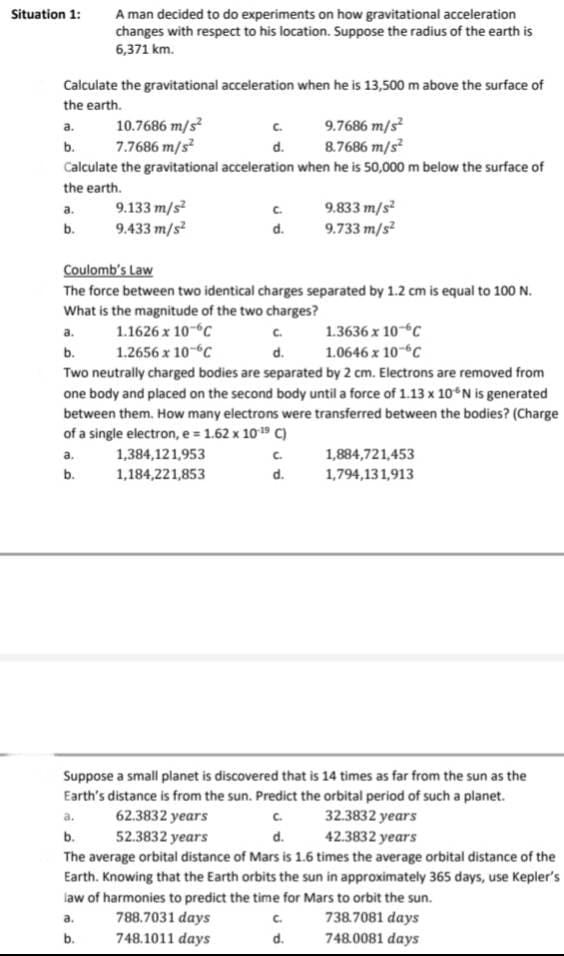Situation 1: A man decided to do experiments on how gravitational acceleration changes with respect to his location. Suppose the radius of the earth is 6,371 km. Calculate the gravitational acceleration when he is 13,500 m above the surface of the earth. a. b. 10.7686 m/s² 9.7686 m/s² 7.7686 m/s² d. 8.7686 m/s² Calculate the gravitational acceleration when he is 50,000 m below the surface of the earth. a. b. 9.133 m/s² 9.433 m/s² C. d. 9.833 m/s² 9.733 m/s²
Situation 1: A man decided to do experiments on how gravitational acceleration changes with respect to his location. Suppose the radius of the earth is 6,371 km. Calculate the gravitational acceleration when he is 13,500 m above the surface of the earth. a. b. 10.7686 m/s² 9.7686 m/s² 7.7686 m/s² d. 8.7686 m/s² Calculate the gravitational acceleration when he is 50,000 m below the surface of the earth. a. b. 9.133 m/s² 9.433 m/s² C. d. 9.833 m/s² 9.733 m/s²
Principles of Physics: A Calculus-Based Text
5th Edition
ISBN:9781133104261
Author:Raymond A. Serway, John W. Jewett
Publisher:Raymond A. Serway, John W. Jewett
Chapter11: Gravity, Planetary Orbits, And The Hydrogen Atom
Section: Chapter Questions
Problem 5P
Related questions
Question

Transcribed Image Text:Situation 1:
A man decided to do experiments on how gravitational acceleration
changes with respect to his location. Suppose the radius of the earth is
6,371 km.
Calculate the gravitational acceleration when he is 13,500 m above the surface of
the earth.
a.
b.
10.7686 m/s²
9.7686 m/s²
7.7686 m/s²
8.7686 m/s²
Calculate the gravitational acceleration when he is 50,000 m below the surface of
the earth.
a.
b.
9.133 m/s²
9.433 m/s²
C.
d.
1,384,121,953
1,184,221,853
C.
d.
Coulomb's Law
The force between two identical charges separated by 1.2 cm is equal to 100 N.
What is the magnitude of the two charges?
a.
1.1626 x 10-C
1.3636 x 10 C
b.
1.2656 x 10 C
d.
1.0646 x 10 C
Two neutrally charged bodies are separated by 2 cm. Electrons are removed from
one body and placed on the second body until a force of 1.13 x 10° N is generated
between them. How many electrons were transferred between the bodies? (Charge
of a single electron, e = 1.62 x 10-¹9 C)
a.
b.
C.
d.
9.833 m/s²
9.733 m/s²
C.
d.
1,884,721,453
1,794,131,913
Suppose a small planet is discovered that is 14 times as far from the sun as the
Earth's distance is from the sun. Predict the orbital period of such a planet.
a.
62.3832 years
C.
32.3832 years
b.
52.3832 years
d.
42.3832 years
The average orbital distance of Mars is 1.6 times the average orbital distance of the
Earth. Knowing that the Earth orbits the sun in approximately 365 days, use Kepler's
law of harmonies to predict the time for Mars to orbit the sun.
a.
788.7031 days
738.7081 days
b.
748.1011 days
748.0081 days
Expert Solution
This question has been solved!
Explore an expertly crafted, step-by-step solution for a thorough understanding of key concepts.
Step by step
Solved in 4 steps with 4 images

Knowledge Booster
Learn more about
Need a deep-dive on the concept behind this application? Look no further. Learn more about this topic, physics and related others by exploring similar questions and additional content below.Recommended textbooks for you

Principles of Physics: A Calculus-Based Text
Physics
ISBN:
9781133104261
Author:
Raymond A. Serway, John W. Jewett
Publisher:
Cengage Learning

Physics for Scientists and Engineers: Foundations…
Physics
ISBN:
9781133939146
Author:
Katz, Debora M.
Publisher:
Cengage Learning

Classical Dynamics of Particles and Systems
Physics
ISBN:
9780534408961
Author:
Stephen T. Thornton, Jerry B. Marion
Publisher:
Cengage Learning

Principles of Physics: A Calculus-Based Text
Physics
ISBN:
9781133104261
Author:
Raymond A. Serway, John W. Jewett
Publisher:
Cengage Learning

Physics for Scientists and Engineers: Foundations…
Physics
ISBN:
9781133939146
Author:
Katz, Debora M.
Publisher:
Cengage Learning

Classical Dynamics of Particles and Systems
Physics
ISBN:
9780534408961
Author:
Stephen T. Thornton, Jerry B. Marion
Publisher:
Cengage Learning

University Physics Volume 1
Physics
ISBN:
9781938168277
Author:
William Moebs, Samuel J. Ling, Jeff Sanny
Publisher:
OpenStax - Rice University

College Physics
Physics
ISBN:
9781938168000
Author:
Paul Peter Urone, Roger Hinrichs
Publisher:
OpenStax College

Physics for Scientists and Engineers, Technology …
Physics
ISBN:
9781305116399
Author:
Raymond A. Serway, John W. Jewett
Publisher:
Cengage Learning